When does a state override of city zoning constitute a "rezoning"? In New York Times coverage of the Atlantic Yards project, apparently.
 On 1/2/06, a Metro section news analysis headlined "A Mayor With Lofty Goals, and Better Than Average Odds of Reaching Them," contained this passage regarding Mayor Bloomberg: ...the fruits of his huge rezoning initiatives along the Brooklyn waterfront and at the Atlantic Yards will not all be realized within four years.
On 1/2/06, a Metro section news analysis headlined "A Mayor With Lofty Goals, and Better Than Average Odds of Reaching Them," contained this passage regarding Mayor Bloomberg: ...the fruits of his huge rezoning initiatives along the Brooklyn waterfront and at the Atlantic Yards will not all be realized within four years.
But there’s a big difference between the waterfront rezoning, a process that involves the City Council and extensive hearings, and the state process governing the Atlantic Yards project, under which the unelected Empire State Development Corporation (ESDC) would override city zoning and allow towers at a scale discontinuous with most nearby blocks.
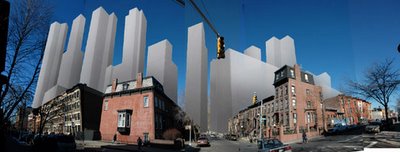 The issue of zoning--or lack thereof--is vital to understanding the appropriate scale of the largest development in Brooklyn's history. Even architect Frank Gehry believes the project, as currently described, is too big. He said on 1/7/06: "It’s coming way back, in a lot of areas, and I guess something will go public in the next few months." Zoning would impose publicly-debated limits on the height and density of the buildings; with "rezoning,"in the Times's parlance, it's up to the developer and the ESDC. (Graphic from OnNYTurf.)
The issue of zoning--or lack thereof--is vital to understanding the appropriate scale of the largest development in Brooklyn's history. Even architect Frank Gehry believes the project, as currently described, is too big. He said on 1/7/06: "It’s coming way back, in a lot of areas, and I guess something will go public in the next few months." Zoning would impose publicly-debated limits on the height and density of the buildings; with "rezoning,"in the Times's parlance, it's up to the developer and the ESDC. (Graphic from OnNYTurf.)
In correspondence, as detailed below, I tried fruitlessly to get this erroneous shorthand corrected. A Times editor evasively said that the details of the "bureaucratic processes" were not needed, and the Times Public Editor, apparently unwilling to recognize a distinction between city and state oversight, endorsed the error as published.
Some corrections, some resistance
So what happened to the journalism of verification?
I've been highly critical of the Times's coverage of this project, in both my report and blog, but I should note that newspaper's performance has improved somewhat in recent months. The Times has paid more attention to the Atlantic Yards issue, though not always, as I have argued, with sufficient skepticism.
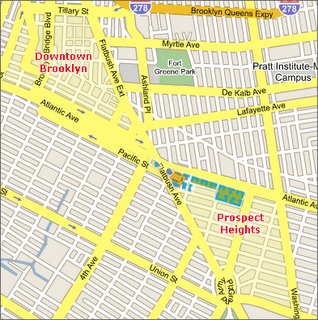 It has published an unavoidable correction or two. It has changed its policies without publishing corrections, such as no longer describing the project as located in Downtown Brooklyn. (Also see coverage here and here.) Yesterday the phrase was "near Downtown Brooklyn." This is a variant of "rowback," which former Times Public Editor Daniel Okrent described in his 3/14/04 column as "a way that a newspaper can cover its butt without admitting it was ever exposed." (The project is outlined just east of Flatbush Avenue and below Atlantic Avenue. Map via NoLandGrab.)
It has published an unavoidable correction or two. It has changed its policies without publishing corrections, such as no longer describing the project as located in Downtown Brooklyn. (Also see coverage here and here.) Yesterday the phrase was "near Downtown Brooklyn." This is a variant of "rowback," which former Times Public Editor Daniel Okrent described in his 3/14/04 column as "a way that a newspaper can cover its butt without admitting it was ever exposed." (The project is outlined just east of Flatbush Avenue and below Atlantic Avenue. Map via NoLandGrab.)
Shorthand errors still occur, but they have come mainly from those--columnists, guest contributors, and political reporters (like the writer of "rezoning")--who dip into the issue rather than the Brooklyn reporter on the beat, Nicholas Confessore.
But on the "rezoning" issue, and some others I will detail in the future, the responses I've received from Times editors, as well as Public Editor Byron Calame, have been defensive, even evasive.
Why? Perhaps Times editors, including the independently-appointed Public Editor, instinctively resist persistent critics like myself, denying a certain percentage of correction requests. Or perhaps Times editors want to limit the number of corrections regarding a single topic. Maybe it's simply a professional proclivity; to quote Slate press critic Jack Shafer: "Individual journalists are a lot like doctors, lawyers, and pilots in that they hate to admit they were wrong no matter what the facts are."
Requesting a correction
 The day the error appeared, on 1/2/06, I wrote to Times Senior Editor Bill Borders:
The day the error appeared, on 1/2/06, I wrote to Times Senior Editor Bill Borders:
The article described "the fruits of [Mayor Bloomberg's] huge rezoning initiatives... at the Atlantic Yards." However, the Atlantic Yards project is proceeding under a state review that overrides city zoning.
Also, the phrasing "at the Atlantic Yards" suggests that it is the name of the railyard that is the single largest piece of Forest City Ratner's planned development--or perhaps the name of some already-existing development parcel. While the proposed development is called "Atlantic Yards," it would encompass both the MTA's 8.3-acre Vanderbilt Yard as well as nearly 14 additional acres that now contain residences, commercial buildings, empty buildings, and city streets. No existing entity is called "the Atlantic Yards." This is a shorthand that the Times and other newspapers have used before, but it erroneously obscures the process for assembling the development site. More details here.
A lengthy response
 Borders passed my request to Deputy Metropolitan Editor Patrick LaForge, who responded 1/18/06:
Borders passed my request to Deputy Metropolitan Editor Patrick LaForge, who responded 1/18/06:
You objected to the shorthand term "Atlantic Yards" for the Ratner proposal, but we use similar shorthand when referring to any development proposal; by now, readers recognize what the phrase means.
I understand that a shorthand phrase may not have the level of detail that you personally would like to see in each and every story. Deciding what to include in each story is a judgment call, and reasonable people will disagree; we do appreciate hearing from you and other readers about these matters, and we do our best to balance the competing interests.
In this case, the Ratner proposal was one detail in a bigger story about the Bloomberg record. And it's worth noting that the writer was speculating about a future in which Atlantic Yards had moved closer to reality. Here is the sentence:
"Yet whether Mr. Bloomberg can emerge in 2010 with the 'great' designation is unclear, as many of his goals may not be realized for a decade or more: today's first graders will still be years away from their high school graduations when he is finished; the fruits of his huge rezoning initiatives along the Brooklyn waterfront and at the Atlantic Yards will not all be realized within four years, nor would the impact of all his fiscal policies."
You also suggest that this sentence should have made a detailed distinction between the city rezoning of the waterfront and the state process (strongly supported by the mayor) that will supersede the zoning at the Atlantic Yards site. We disagree. We have reported the specifics of the bureaucratic processes before, in articles specifically about the Atlantic Yards project, and we will do so again, but they were not needed here.
We are committed to reporting on this controversy fairly and accurately, and we do appreciate your continued vigilance in holding us to that promise. Thank you for writing. (Bloomberg photo from NYC.gov.)
Responding to the Times's misreading
I wrote back to LaForge on 1/19/06:
Thanks for your response; I understand that reasonable people may differ.
I recognize that further dialogue on this may be unproductive, but I think that I may not have been as clear as possible and also that you may have misread my criticisms. Thus, I'm following up.
1) Rezoning.
I did not "suggest that this sentence should have made a detailed distinction between the city rezoning of the waterfront and the state process (strongly supported by the mayor) that will supersede the zoning at the Atlantic Yards site."
While my blog post analyzed the differences at length, I did not there or in my email request a *detailed* distinction. Nor did I offer an alternative formulation. Spurred to do so, here goes:
"the fruits of his huge rezoning initiatives along the Brooklyn waterfront and at the Atlantic Yards"
could have more accurately (yet concisely) been revised to:
"the fruits of his major land use initiatives..."
or
"the fruits of major land use changes he advocated..."
It's not rezoning. The ESDC process at Atlantic Yards bypasses city review; in fact, the lawsuit filed yesterday against the ESDC argues: "ESDC's authority constitutes a disenfranchisement of Brooklyn residents who otherwise could rely upon the City zoning regulations and the public review process embodied in ULURP."
2. At the Atlantic Yards.
As I previously wrote, the phrasing "at the Atlantic Yards" suggests that it is the name of the railyard or some already-existing development parcel. The key is the use of the word "the," not the use of the project name.
I think that the use of the word "for" would have more clearly conveyed that the name involves a project, not an already-established location. The Brooklyn waterfront is a place; the Atlantic Yards is a project. Thus, I think it would have been more precise to write:
"fruits of his... initiatives along the Brooklyn waterfront and for the Atlantic Yards"
I do think it would be more accurate to say "for the Atlantic Yards project" than "for the Atlantic Yards," but either formulation avoids the suggestion, as in "at the Atlantic Yards," that it is a place.
These may seem like small distinctions, but do recognize that I was not arguing for greater detail, just the avoidance of details that could mislead.
Mollifying the critic?
LaForge responded later that day:
We don't think the article was misleading, but thank you for your further suggestions. I will distribute them to the writers and editors who handle these stories, for their consideration when they prepare future articles. You should know that we have prepared a style sheet covering some of the factual pitfalls in covering this controversy, and your efforts have been most helpful in that regard. So, again, thank you, and do not hesitate to write again if you have concerns.
That was cordial (and likely refers to the "Downtown Brooklyn" issue, among others), but it doesn’t obscure the misrepresentation involved in calling something a rezoning when it’s not.
Appealing to the Public Editor
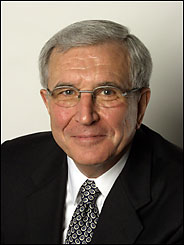 I decided to appeal to Public Editor Calame (photo from NYTimes.com), though, given his lack of attention to the newspaper's coverage of the Atlantic Yards issue, or to the Times Tower issue, I wasn't optimistic. I chose to focus on rezoning, a less ambiguous issue than "at the Atlantic Yards." I wrote:
I decided to appeal to Public Editor Calame (photo from NYTimes.com), though, given his lack of attention to the newspaper's coverage of the Atlantic Yards issue, or to the Times Tower issue, I wasn't optimistic. I chose to focus on rezoning, a less ambiguous issue than "at the Atlantic Yards." I wrote:
I hesitate to burden you with arbitrating factual disputes, since I know you have more complex issues on your plate, but this issue seems quite clear-cut to me. So I'm asking you to evaluate whether Times editors have adequately dealt with my correction request.
A 1/2/06 Metro section news analysis headlined "A Mayor With Lofty Goals, and Better Than Average Odds of Reaching Them," contained this passage regarding Mayor Bloomberg:
"the fruits of his huge rezoning initiatives along the Brooklyn waterfront and at the Atlantic Yards will not all be realized within four years."
I wrote a blog post citing two errors in that sentence, but in this case I'd like to focus on the more clear-cut one. There has been *no* rezoning for the Atlantic Yards project.
In fact, because the project is under the auspices of the Empire State Development Corporation (ESDC), it would override city zoning and avoid more stringent city oversight standards.
As you can see, deputy Metro Editor Patrick LaForge contends that "rezoning initiative" is an acceptable shorthand for Mayor Bloomberg's support for the state process that will supersede the zoning.
I disagree. Overriding zoning is not the same as rezoning; the latter requires a level of participation by local elected officials and citizens that is absent from the state process. It is an issue of substance, not shorthand.
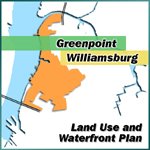 For example, the rezoning along the Brooklyn waterfront proposes "a range of residential zoning districts to match the distinct context and scale of each well-established neighborhood and to require that scale in adjoining underbuilt areas where new development is possible."
For example, the rezoning along the Brooklyn waterfront proposes "a range of residential zoning districts to match the distinct context and scale of each well-established neighborhood and to require that scale in adjoining underbuilt areas where new development is possible."
...By contrast, for the Atlantic Yards development, the decision is made by the developer, with the only input potential mitigation recommended after the fact by the Environmental Impact Statement issued by the ESDC.
I was not asking for this all to be explained, just pointing out how the use of the term "rezoning" was inappropriate.
The Public Editor: nope
Calame responded on 1/20/06:
I have reviewed your exchanges with editors in the newsroom.
I don't think the reference to "huge rezoning initiatives" requires a correction.
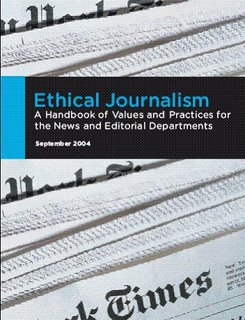 He didn't give a reason. Does he consider "rezoning" to be a vague term as opposed to one with a specific meaning?
He didn't give a reason. Does he consider "rezoning" to be a vague term as opposed to one with a specific meaning?
The Times's policy, according to its 2004 Ethical Journalism handbook, states:
The Times treats its readers as fairly and openly as possible. In print and online, we tell our readers the complete, unvarnished truth as best we can learn it. It is our policy to correct our errors, large and small, as soon as we become aware of them.
Does "rezoning" constitute "the complete, unvarnished truth"? I think Times editors, including Calame, should take this policy more seriously.
 On 1/2/06, a Metro section news analysis headlined "A Mayor With Lofty Goals, and Better Than Average Odds of Reaching Them," contained this passage regarding Mayor Bloomberg: ...the fruits of his huge rezoning initiatives along the Brooklyn waterfront and at the Atlantic Yards will not all be realized within four years.
On 1/2/06, a Metro section news analysis headlined "A Mayor With Lofty Goals, and Better Than Average Odds of Reaching Them," contained this passage regarding Mayor Bloomberg: ...the fruits of his huge rezoning initiatives along the Brooklyn waterfront and at the Atlantic Yards will not all be realized within four years.But there’s a big difference between the waterfront rezoning, a process that involves the City Council and extensive hearings, and the state process governing the Atlantic Yards project, under which the unelected Empire State Development Corporation (ESDC) would override city zoning and allow towers at a scale discontinuous with most nearby blocks.
 The issue of zoning--or lack thereof--is vital to understanding the appropriate scale of the largest development in Brooklyn's history. Even architect Frank Gehry believes the project, as currently described, is too big. He said on 1/7/06: "It’s coming way back, in a lot of areas, and I guess something will go public in the next few months." Zoning would impose publicly-debated limits on the height and density of the buildings; with "rezoning,"in the Times's parlance, it's up to the developer and the ESDC. (Graphic from OnNYTurf.)
The issue of zoning--or lack thereof--is vital to understanding the appropriate scale of the largest development in Brooklyn's history. Even architect Frank Gehry believes the project, as currently described, is too big. He said on 1/7/06: "It’s coming way back, in a lot of areas, and I guess something will go public in the next few months." Zoning would impose publicly-debated limits on the height and density of the buildings; with "rezoning,"in the Times's parlance, it's up to the developer and the ESDC. (Graphic from OnNYTurf.)In correspondence, as detailed below, I tried fruitlessly to get this erroneous shorthand corrected. A Times editor evasively said that the details of the "bureaucratic processes" were not needed, and the Times Public Editor, apparently unwilling to recognize a distinction between city and state oversight, endorsed the error as published.
Some corrections, some resistance
So what happened to the journalism of verification?
I've been highly critical of the Times's coverage of this project, in both my report and blog, but I should note that newspaper's performance has improved somewhat in recent months. The Times has paid more attention to the Atlantic Yards issue, though not always, as I have argued, with sufficient skepticism.
 It has published an unavoidable correction or two. It has changed its policies without publishing corrections, such as no longer describing the project as located in Downtown Brooklyn. (Also see coverage here and here.) Yesterday the phrase was "near Downtown Brooklyn." This is a variant of "rowback," which former Times Public Editor Daniel Okrent described in his 3/14/04 column as "a way that a newspaper can cover its butt without admitting it was ever exposed." (The project is outlined just east of Flatbush Avenue and below Atlantic Avenue. Map via NoLandGrab.)
It has published an unavoidable correction or two. It has changed its policies without publishing corrections, such as no longer describing the project as located in Downtown Brooklyn. (Also see coverage here and here.) Yesterday the phrase was "near Downtown Brooklyn." This is a variant of "rowback," which former Times Public Editor Daniel Okrent described in his 3/14/04 column as "a way that a newspaper can cover its butt without admitting it was ever exposed." (The project is outlined just east of Flatbush Avenue and below Atlantic Avenue. Map via NoLandGrab.)Shorthand errors still occur, but they have come mainly from those--columnists, guest contributors, and political reporters (like the writer of "rezoning")--who dip into the issue rather than the Brooklyn reporter on the beat, Nicholas Confessore.
But on the "rezoning" issue, and some others I will detail in the future, the responses I've received from Times editors, as well as Public Editor Byron Calame, have been defensive, even evasive.
Why? Perhaps Times editors, including the independently-appointed Public Editor, instinctively resist persistent critics like myself, denying a certain percentage of correction requests. Or perhaps Times editors want to limit the number of corrections regarding a single topic. Maybe it's simply a professional proclivity; to quote Slate press critic Jack Shafer: "Individual journalists are a lot like doctors, lawyers, and pilots in that they hate to admit they were wrong no matter what the facts are."
Requesting a correction
 The day the error appeared, on 1/2/06, I wrote to Times Senior Editor Bill Borders:
The day the error appeared, on 1/2/06, I wrote to Times Senior Editor Bill Borders:The article described "the fruits of [Mayor Bloomberg's] huge rezoning initiatives... at the Atlantic Yards." However, the Atlantic Yards project is proceeding under a state review that overrides city zoning.
Also, the phrasing "at the Atlantic Yards" suggests that it is the name of the railyard that is the single largest piece of Forest City Ratner's planned development--or perhaps the name of some already-existing development parcel. While the proposed development is called "Atlantic Yards," it would encompass both the MTA's 8.3-acre Vanderbilt Yard as well as nearly 14 additional acres that now contain residences, commercial buildings, empty buildings, and city streets. No existing entity is called "the Atlantic Yards." This is a shorthand that the Times and other newspapers have used before, but it erroneously obscures the process for assembling the development site. More details here.
A lengthy response
 Borders passed my request to Deputy Metropolitan Editor Patrick LaForge, who responded 1/18/06:
Borders passed my request to Deputy Metropolitan Editor Patrick LaForge, who responded 1/18/06:You objected to the shorthand term "Atlantic Yards" for the Ratner proposal, but we use similar shorthand when referring to any development proposal; by now, readers recognize what the phrase means.
I understand that a shorthand phrase may not have the level of detail that you personally would like to see in each and every story. Deciding what to include in each story is a judgment call, and reasonable people will disagree; we do appreciate hearing from you and other readers about these matters, and we do our best to balance the competing interests.
In this case, the Ratner proposal was one detail in a bigger story about the Bloomberg record. And it's worth noting that the writer was speculating about a future in which Atlantic Yards had moved closer to reality. Here is the sentence:
"Yet whether Mr. Bloomberg can emerge in 2010 with the 'great' designation is unclear, as many of his goals may not be realized for a decade or more: today's first graders will still be years away from their high school graduations when he is finished; the fruits of his huge rezoning initiatives along the Brooklyn waterfront and at the Atlantic Yards will not all be realized within four years, nor would the impact of all his fiscal policies."
You also suggest that this sentence should have made a detailed distinction between the city rezoning of the waterfront and the state process (strongly supported by the mayor) that will supersede the zoning at the Atlantic Yards site. We disagree. We have reported the specifics of the bureaucratic processes before, in articles specifically about the Atlantic Yards project, and we will do so again, but they were not needed here.
We are committed to reporting on this controversy fairly and accurately, and we do appreciate your continued vigilance in holding us to that promise. Thank you for writing. (Bloomberg photo from NYC.gov.)
Responding to the Times's misreading
I wrote back to LaForge on 1/19/06:
Thanks for your response; I understand that reasonable people may differ.
I recognize that further dialogue on this may be unproductive, but I think that I may not have been as clear as possible and also that you may have misread my criticisms. Thus, I'm following up.
1) Rezoning.
I did not "suggest that this sentence should have made a detailed distinction between the city rezoning of the waterfront and the state process (strongly supported by the mayor) that will supersede the zoning at the Atlantic Yards site."
While my blog post analyzed the differences at length, I did not there or in my email request a *detailed* distinction. Nor did I offer an alternative formulation. Spurred to do so, here goes:
"the fruits of his huge rezoning initiatives along the Brooklyn waterfront and at the Atlantic Yards"
could have more accurately (yet concisely) been revised to:
"the fruits of his major land use initiatives..."
or
"the fruits of major land use changes he advocated..."
It's not rezoning. The ESDC process at Atlantic Yards bypasses city review; in fact, the lawsuit filed yesterday against the ESDC argues: "ESDC's authority constitutes a disenfranchisement of Brooklyn residents who otherwise could rely upon the City zoning regulations and the public review process embodied in ULURP."
2. At the Atlantic Yards.
As I previously wrote, the phrasing "at the Atlantic Yards" suggests that it is the name of the railyard or some already-existing development parcel. The key is the use of the word "the," not the use of the project name.
I think that the use of the word "for" would have more clearly conveyed that the name involves a project, not an already-established location. The Brooklyn waterfront is a place; the Atlantic Yards is a project. Thus, I think it would have been more precise to write:
"fruits of his... initiatives along the Brooklyn waterfront and for the Atlantic Yards"
I do think it would be more accurate to say "for the Atlantic Yards project" than "for the Atlantic Yards," but either formulation avoids the suggestion, as in "at the Atlantic Yards," that it is a place.
These may seem like small distinctions, but do recognize that I was not arguing for greater detail, just the avoidance of details that could mislead.
Mollifying the critic?
LaForge responded later that day:
We don't think the article was misleading, but thank you for your further suggestions. I will distribute them to the writers and editors who handle these stories, for their consideration when they prepare future articles. You should know that we have prepared a style sheet covering some of the factual pitfalls in covering this controversy, and your efforts have been most helpful in that regard. So, again, thank you, and do not hesitate to write again if you have concerns.
That was cordial (and likely refers to the "Downtown Brooklyn" issue, among others), but it doesn’t obscure the misrepresentation involved in calling something a rezoning when it’s not.
Appealing to the Public Editor
 I decided to appeal to Public Editor Calame (photo from NYTimes.com), though, given his lack of attention to the newspaper's coverage of the Atlantic Yards issue, or to the Times Tower issue, I wasn't optimistic. I chose to focus on rezoning, a less ambiguous issue than "at the Atlantic Yards." I wrote:
I decided to appeal to Public Editor Calame (photo from NYTimes.com), though, given his lack of attention to the newspaper's coverage of the Atlantic Yards issue, or to the Times Tower issue, I wasn't optimistic. I chose to focus on rezoning, a less ambiguous issue than "at the Atlantic Yards." I wrote:I hesitate to burden you with arbitrating factual disputes, since I know you have more complex issues on your plate, but this issue seems quite clear-cut to me. So I'm asking you to evaluate whether Times editors have adequately dealt with my correction request.
A 1/2/06 Metro section news analysis headlined "A Mayor With Lofty Goals, and Better Than Average Odds of Reaching Them," contained this passage regarding Mayor Bloomberg:
"the fruits of his huge rezoning initiatives along the Brooklyn waterfront and at the Atlantic Yards will not all be realized within four years."
I wrote a blog post citing two errors in that sentence, but in this case I'd like to focus on the more clear-cut one. There has been *no* rezoning for the Atlantic Yards project.
In fact, because the project is under the auspices of the Empire State Development Corporation (ESDC), it would override city zoning and avoid more stringent city oversight standards.
As you can see, deputy Metro Editor Patrick LaForge contends that "rezoning initiative" is an acceptable shorthand for Mayor Bloomberg's support for the state process that will supersede the zoning.
I disagree. Overriding zoning is not the same as rezoning; the latter requires a level of participation by local elected officials and citizens that is absent from the state process. It is an issue of substance, not shorthand.
 For example, the rezoning along the Brooklyn waterfront proposes "a range of residential zoning districts to match the distinct context and scale of each well-established neighborhood and to require that scale in adjoining underbuilt areas where new development is possible."
For example, the rezoning along the Brooklyn waterfront proposes "a range of residential zoning districts to match the distinct context and scale of each well-established neighborhood and to require that scale in adjoining underbuilt areas where new development is possible."...By contrast, for the Atlantic Yards development, the decision is made by the developer, with the only input potential mitigation recommended after the fact by the Environmental Impact Statement issued by the ESDC.
I was not asking for this all to be explained, just pointing out how the use of the term "rezoning" was inappropriate.
The Public Editor: nope
Calame responded on 1/20/06:
I have reviewed your exchanges with editors in the newsroom.
I don't think the reference to "huge rezoning initiatives" requires a correction.
 He didn't give a reason. Does he consider "rezoning" to be a vague term as opposed to one with a specific meaning?
He didn't give a reason. Does he consider "rezoning" to be a vague term as opposed to one with a specific meaning? The Times's policy, according to its 2004 Ethical Journalism handbook, states:
The Times treats its readers as fairly and openly as possible. In print and online, we tell our readers the complete, unvarnished truth as best we can learn it. It is our policy to correct our errors, large and small, as soon as we become aware of them.
Does "rezoning" constitute "the complete, unvarnished truth"? I think Times editors, including Calame, should take this policy more seriously.
Comments
Post a Comment